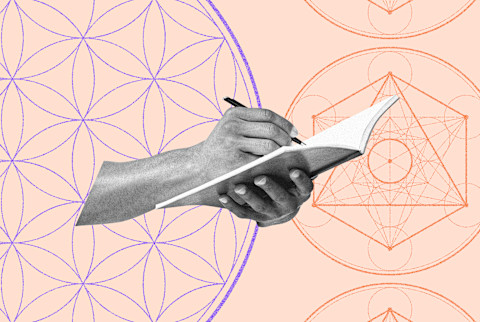Mandalas 101: A Guide To Their History, Meaning & How To Make Them

Without even realizing it, you might have made a mandala before. Ever cut out snowflakes as a kid? Or maybe doodled a complex repetitive pattern in a notebook? There's a reason we innately feel pulled to these beautiful and intricate designs: Studies show that making mandalas might actually decrease anxiety1 and guide us into a meditative state. Here's an introduction to the history and symbolism behind mandalas, and how you can make one for yourself.
What are mandalas?
A mandala is an arrangement of simple shapes repeated in a circular pattern. (Mandala actually comes from the Sanskrit word for "circle.") For examples of mandalas, we can look to nature (think flowers like roses, chrysanthemums, and dahlias; ripples in a body of water; and snowflakes) as well as ancient art. The first mandalas were thought to be created by Buddhist monks during the first century B.C. They quickly spread throughout Asia to Tibet, China, and Japan, too.
In the years since, Buddhist monks have continued to create intricate mandalas out of sand for festivals and sacred ceremonies. These works of art are then swept up—the sand blended and poured into a river. This might seem tragic, but it helps us remember that everything is temporary. We can appreciate beauty in front of us without missing it when it is gone.
Today, the process of creating (and sometimes destroying) mandalas is an art form, spiritual practice, and meditation tool.
What do mandalas represent?
Most mandalas we see today are not necessarily religious or in line with any particular spiritual background. But it's important to note that in Buddhism and Hinduism, mandalas are sacred objects that represent both the universe and a person's quest for enlightenment. According to the Ancient History Encyclopedia, the center of a mandala symbolizes a palace, and the shapes surrounding it are a source of protection. Each layer symbolizes a quality (compassion or devotion, for example) that one must obtain before accessing the palace. In this sense, mandalas represent the journey of life and the path toward wisdom and self-actualization.
How to draw mandalas of your own.
Drawing mandalas can be a very calming and meditative experience. Here's a step-by-step guide to creating one:
What you'll need:
- Paper
- Something to draw circles with (like a geometry compass)
- A ruler
- Pencil
- Markers, colored pencils or pens
How to draw a mandala:
- In pencil, make a small circle using your compass, roughly in the center of your paper.
- Using the same center point, draw consecutively bigger circles around the first one. (It doesn't matter if the circles are equal distant apart or if their distances vary. You just want them to all start from the same center point, so everything is symmetrical.
- Once you've drawn some circles, making a bull's-eye or target shape on your paper, draw a vertical line down the middle of your circles in pencil. (You'll eventually erase the pencil.)
- Now draw a horizontal line through the middle to create a plus sign.
- Split those pieces up into further parts again. You can do as many as you like, as long as each wedge is the same size. This grid serves are your guideline markings, which you will erase.
- Now is the fun part! Starting from the center, draw whatever shape you want inside the first wedge. Repeat that same shape in the wedge next to it, and the one next to that one, and so on, rotating your page as you go until all wedges are drawn in. Do you see the start of your mandala?
- Keep working your way outward using the circles and lines as your markers. This helps keep the symmetry in your mandala. Just keep drawing the same shape in each wedge and working outward every time you complete a full circle.
Remember: This should be relaxing. You don't need to give yourself rules or judge the finished creation. Simply start from the center and work your way out. Start small, move slowly, and be kind to yourself. Let mandala drawing take you to a quieter and more peaceful place. If you're more of a visual learner, here's a video that illustrates how it's done.
Drawing mandalas is a wonderful way to release yourself from "the monkey mind" and move away from your to-do lists, schedules, worries, and fears for a bit. The idea is to zone out and let yourself enter a creative flow state. So turn on your favorite relaxing music, light some candles, take a few deep breaths, and let your subconscious mind take over as you draw your mandala masterpiece.
